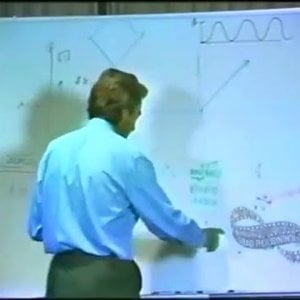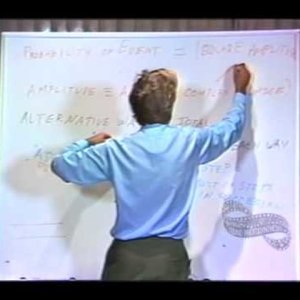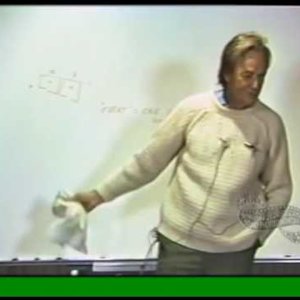You are using an out of date browser. It may not display this or other websites correctly.
You should upgrade or use an alternative browser.
You should upgrade or use an alternative browser.
What is Quantum mechancis: Definition and 19 Discussions
No Wikipedia entry exists for this tag
-
H
How to find the eigenvector for a perturbated Hamiltonian?
Hi, I have to find the eigenvalue (first order) and eigenvector (0 order) for the first and second excited state (degenerate) for a perturbated hamiltonian. However, I don't see how to find the eigenvectors. To find the eigenvalues for the first excited state I build this matrix ##...- happyparticle
- Thread
- Replies: 13
- Forum: Advanced Physics Homework Help
-

I Exploring Electromagnetism & Quantum Mechanics
In classical electromagnetism I think I have understood the following(please correct me if something is wrong): A charge produces an electric field, a charge moving with constant velocity produces a magnetic field, an accelerating charge emits electromagnetic radiation. In radio antennas this is...- sol47739
- Thread
- Replies: 4
- Forum: Quantum Physics
-
S
Average speed of a probability density wave and wave packets
Show that ##v_{av}=\frac{\hbar k_2 + \hbar k_1}{2m}## is equal to ##v_{av}=\frac{\omega_2 - \omega_1}{k_2-k_1}##. Which of the identities listed above (if any) would make the sign change between ##k_2## and ##k_1##? One can attain a "wave packet" by superposing two or more sinusoidal waves...- schniefen
- Thread
- Replies: 17
- Forum: Introductory Physics Homework Help
-
I The thermal interpretation of quantum physics
A complete description of the thermal interpretation of quantum physics can be found in my just finished papers (for the bare bones, see Section 2.5 of Part II) Foundations of quantum physics I. A critique of the tradition, Foundations of quantum physics II. The thermal interpretation...- A. Neumaier
- Thread
- Replies: 826
- Forum: Quantum Interpretations and Foundations
-

A Confusing eigensolutions of a wave function
Consider a potential cavity $$V(r)=\begin{cases}\infty, &x\in(-\infty,0]\\\frac{\hslash^2}{m}\Omega\delta(x-a), &x\in(0,\infty)\end{cases}$$ The eigenfunction of the wave function in this field suffices $$-\frac{\hslash^2}{2m}\frac{d^2\psi}{dx^2}+\frac{\hslash^2}{m}\Omega\delta(x-a)\psi=E\psi$$...- Yourong Zang
- Thread
- Replies: 3
- Forum: Quantum Physics
-
M
Quantum Teleportation Homework: Deriving EPR Pair & Measuring Spin 1/2 Particles
Homework Statement This isn't exactly a problem but rather a problem in understanding the derivation of the phenomenon, or more precisely, one step in the derivation. In the following we will consider the EPR pair of two spin ##1/2## particles, where the state can be written as $$ \vert...- Markus Kahn
- Thread
- Replies: 3
- Forum: Advanced Physics Homework Help
-

[QM] Two-Particle Systems: overlapping/non-overlapping wavefunctions
Homework Statement Hi, I was reading Griffiths and stumble upon some questions. This is from 5.1.2 Exchange Forces. The section is trying to work out the square of the separation distance between two particles, $$\langle (x_1 - x_2)^2 \rangle = \langle x_1^2 \rangle + \langle x_2^2 \rangle -...- WeiShan Ng
- Thread
- Replies: 2
- Forum: Advanced Physics Homework Help
-

Richard Feynman - Quantum Mechanical View of Reality 1
- Wrichik Basu
- Media item
- quantum mechancis
- Comments: 0
- Category: Quantum
-

Richard Feynman - Quantum Mechanical View of Reality 2
- Wrichik Basu
- Media item
- quantum mechancis
- Comments: 0
- Category: Quantum
-

Richard Feynman - Quantum Mechanical View of Reality 3
- Wrichik Basu
- Media item
- quantum mechancis
- Comments: 0
- Category: Quantum
-

Richard Feynman - Quantum Mechanical View of Reality 4
- Wrichik Basu
- Media item
- quantum mechancis
- Comments: 0
- Category: Quantum
-
M
Quantum Jump that produces an infrared line?
1. A certain type of atom has only four energy levels, as shown in the diagram. The "spectral lines" produces by this element are all visible, except for one infrared line. The quantum jump that produces the infrared line is: (see attached file) A) state 4 to 3.B) state 4 to 1.C) state 2 to 1...- MarilizeLegajuanas
- Thread
- Replies: 2
- Forum: Introductory Physics Homework Help
-

Identical particles and separating the Schrodinger equation
Homework Statement Two identical particles, each of mass m, move in one dimension in the potential $$V = \frac{1}{2}A(x_1^2+x_2^2)+ \frac{1}{2}B(x_1-x_2)^2$$ where A and B are positive constants and ##x_1## and ##x_2## denote the positions of the particles. a) Show that the Schrodinger equation...- mangojuice14
- Thread
- Replies: 6
- Forum: Advanced Physics Homework Help
-
J
I Difference between statistical and dynamical properties
Hi All, What are the main differences between statistical and dynamics properties in physics? Could you please explain the difference for problems in both classical and quantum mechanics. For instance, path integral molecular dynamics is supposed to give statistical properties of a quantum...- junt
- Thread
- Replies: 4
- Forum: Quantum Physics
-
F
Constructing the input state given the probabilities
Homework Statement The spin components of a beam of atoms prepared in the state ##|\psi_{in}\rangle## are measured and the following experimental probabilities are obtained, $$P_{+}=\frac{1}{2}, \quad P_{+x}=\frac{3}{4}, \quad P_{+y}=0.067$$ $$P_{-}=\frac{1}{2}, \quad P_{-x}=\frac{1}{4}, \quad...- Figaro
- Thread
- Replies: 13
- Forum: Advanced Physics Homework Help
-
A
Allowed momentum values for a plane wave
Hi all, This is from a past exam paper: At t=0 the state of a particle is described by the wavefunction $$ \Psi (x,0) =A(iexp(ikx)+2exp(-ikx)) $$ This is between positive and negative infinity - not in a potential well. What values of momentum are allowed, and with what probability in each...- alec_grunn
- Thread
- Replies: 3
- Forum: Introductory Physics Homework Help
-
M
Quantum Mechanics (finding the Hamiltonian of a quantum top)
Hello, This was part of my midterm exam that i couldn't solve. Any help is extremely appreciated. Problem: The K.E. of a rotating top is given as L^2/2I where L is its angular momentum and I is its moment of inertia. Consider a charged top placed at a constant magnetic field. Assume that the...- MelissaM
- Thread
- Replies: 3
- Forum: Advanced Physics Homework Help
-

Exploring the Probabilistic Nature of Quantum Mechanics
Why is Quantum mechanics probabilistic? what prevents it from being deterministic, like classical mechanics ?(is it the lack of information about the processes and the forces applied at this scale?)- AlexGLSY
- Thread
- Replies: 5
- Forum: Quantum Physics
-
K
Confusion Related to Planck Mass
Hi all, According to quantum mechanics, the graviton is the measure of the smallest amount of curvature possible in space-time. I read that the mass which would be required to create this curvature is Planck Mass which is close to the value 10^-5g. But the elementary particles, like electrons...- klen
- Thread
- Replies: 7
- Forum: Quantum Physics